Catholic School Principal: Leadership, Vision, and Professional Growth
VerifiedAdded on 2022/11/24
|11
|4116
|234
Report
AI Summary
This report examines the evolving role of Catholic school principals, contrasting early administrative practices with modern leadership styles. It emphasizes the shift towards transformational leadership, focusing on teacher quality, student achievement, and professional development. The report highlights the importance of a shared vision and goals to empower school resources, including teachers, and foster a positive school culture. It explores leadership styles, the role of the principal as an instructional leader, and the significance of professional growth for both teachers and principals. The report also discusses the impact of vision and mission on school culture, the practices of effective leaders, and the need for continuous improvement in a dynamic educational environment. Ultimately, the report underscores the multifaceted responsibilities of Catholic school principals in promoting student success and creating a supportive learning environment.
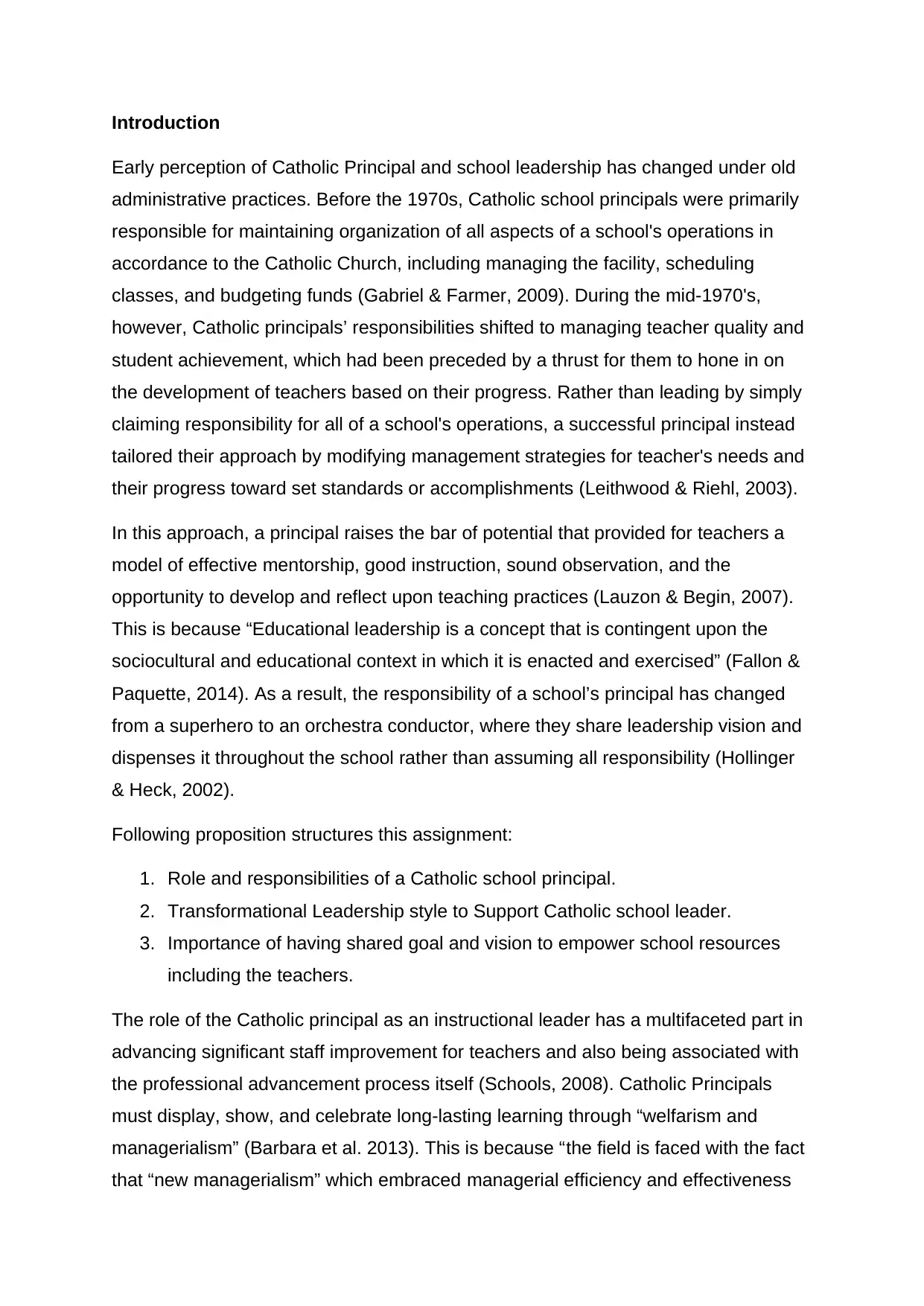
Introduction
Early perception of Catholic Principal and school leadership has changed under old
administrative practices. Before the 1970s, Catholic school principals were primarily
responsible for maintaining organization of all aspects of a school's operations in
accordance to the Catholic Church, including managing the facility, scheduling
classes, and budgeting funds (Gabriel & Farmer, 2009). During the mid-1970's,
however, Catholic principals’ responsibilities shifted to managing teacher quality and
student achievement, which had been preceded by a thrust for them to hone in on
the development of teachers based on their progress. Rather than leading by simply
claiming responsibility for all of a school's operations, a successful principal instead
tailored their approach by modifying management strategies for teacher's needs and
their progress toward set standards or accomplishments (Leithwood & Riehl, 2003).
In this approach, a principal raises the bar of potential that provided for teachers a
model of effective mentorship, good instruction, sound observation, and the
opportunity to develop and reflect upon teaching practices (Lauzon & Begin, 2007).
This is because “Educational leadership is a concept that is contingent upon the
sociocultural and educational context in which it is enacted and exercised” (Fallon &
Paquette, 2014). As a result, the responsibility of a school’s principal has changed
from a superhero to an orchestra conductor, where they share leadership vision and
dispenses it throughout the school rather than assuming all responsibility (Hollinger
& Heck, 2002).
Following proposition structures this assignment:
1. Role and responsibilities of a Catholic school principal.
2. Transformational Leadership style to Support Catholic school leader.
3. Importance of having shared goal and vision to empower school resources
including the teachers.
The role of the Catholic principal as an instructional leader has a multifaceted part in
advancing significant staff improvement for teachers and also being associated with
the professional advancement process itself (Schools, 2008). Catholic Principals
must display, show, and celebrate long-lasting learning through “welfarism and
managerialism” (Barbara et al. 2013). This is because “the field is faced with the fact
that “new managerialism” which embraced managerial efficiency and effectiveness
Early perception of Catholic Principal and school leadership has changed under old
administrative practices. Before the 1970s, Catholic school principals were primarily
responsible for maintaining organization of all aspects of a school's operations in
accordance to the Catholic Church, including managing the facility, scheduling
classes, and budgeting funds (Gabriel & Farmer, 2009). During the mid-1970's,
however, Catholic principals’ responsibilities shifted to managing teacher quality and
student achievement, which had been preceded by a thrust for them to hone in on
the development of teachers based on their progress. Rather than leading by simply
claiming responsibility for all of a school's operations, a successful principal instead
tailored their approach by modifying management strategies for teacher's needs and
their progress toward set standards or accomplishments (Leithwood & Riehl, 2003).
In this approach, a principal raises the bar of potential that provided for teachers a
model of effective mentorship, good instruction, sound observation, and the
opportunity to develop and reflect upon teaching practices (Lauzon & Begin, 2007).
This is because “Educational leadership is a concept that is contingent upon the
sociocultural and educational context in which it is enacted and exercised” (Fallon &
Paquette, 2014). As a result, the responsibility of a school’s principal has changed
from a superhero to an orchestra conductor, where they share leadership vision and
dispenses it throughout the school rather than assuming all responsibility (Hollinger
& Heck, 2002).
Following proposition structures this assignment:
1. Role and responsibilities of a Catholic school principal.
2. Transformational Leadership style to Support Catholic school leader.
3. Importance of having shared goal and vision to empower school resources
including the teachers.
The role of the Catholic principal as an instructional leader has a multifaceted part in
advancing significant staff improvement for teachers and also being associated with
the professional advancement process itself (Schools, 2008). Catholic Principals
must display, show, and celebrate long-lasting learning through “welfarism and
managerialism” (Barbara et al. 2013). This is because “the field is faced with the fact
that “new managerialism” which embraced managerial efficiency and effectiveness
Paraphrase This Document
Need a fresh take? Get an instant paraphrase of this document with our AI Paraphraser
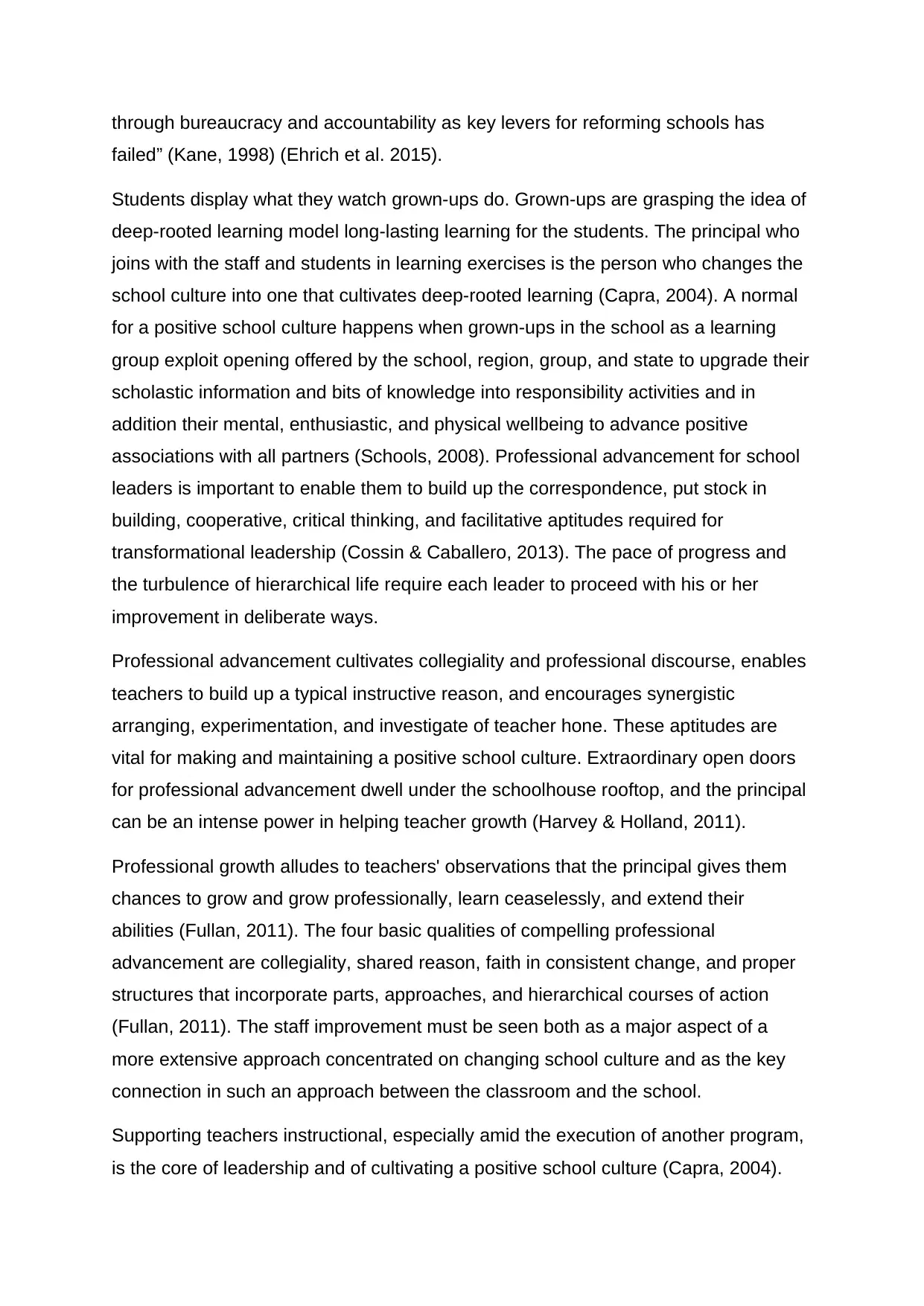
through bureaucracy and accountability as key levers for reforming schools has
failed” (Kane, 1998) (Ehrich et al. 2015).
Students display what they watch grown-ups do. Grown-ups are grasping the idea of
deep-rooted learning model long-lasting learning for the students. The principal who
joins with the staff and students in learning exercises is the person who changes the
school culture into one that cultivates deep-rooted learning (Capra, 2004). A normal
for a positive school culture happens when grown-ups in the school as a learning
group exploit opening offered by the school, region, group, and state to upgrade their
scholastic information and bits of knowledge into responsibility activities and in
addition their mental, enthusiastic, and physical wellbeing to advance positive
associations with all partners (Schools, 2008). Professional advancement for school
leaders is important to enable them to build up the correspondence, put stock in
building, cooperative, critical thinking, and facilitative aptitudes required for
transformational leadership (Cossin & Caballero, 2013). The pace of progress and
the turbulence of hierarchical life require each leader to proceed with his or her
improvement in deliberate ways.
Professional advancement cultivates collegiality and professional discourse, enables
teachers to build up a typical instructive reason, and encourages synergistic
arranging, experimentation, and investigate of teacher hone. These aptitudes are
vital for making and maintaining a positive school culture. Extraordinary open doors
for professional advancement dwell under the schoolhouse rooftop, and the principal
can be an intense power in helping teacher growth (Harvey & Holland, 2011).
Professional growth alludes to teachers' observations that the principal gives them
chances to grow and grow professionally, learn ceaselessly, and extend their
abilities (Fullan, 2011). The four basic qualities of compelling professional
advancement are collegiality, shared reason, faith in consistent change, and proper
structures that incorporate parts, approaches, and hierarchical courses of action
(Fullan, 2011). The staff improvement must be seen both as a major aspect of a
more extensive approach concentrated on changing school culture and as the key
connection in such an approach between the classroom and the school.
Supporting teachers instructional, especially amid the execution of another program,
is the core of leadership and of cultivating a positive school culture (Capra, 2004).
failed” (Kane, 1998) (Ehrich et al. 2015).
Students display what they watch grown-ups do. Grown-ups are grasping the idea of
deep-rooted learning model long-lasting learning for the students. The principal who
joins with the staff and students in learning exercises is the person who changes the
school culture into one that cultivates deep-rooted learning (Capra, 2004). A normal
for a positive school culture happens when grown-ups in the school as a learning
group exploit opening offered by the school, region, group, and state to upgrade their
scholastic information and bits of knowledge into responsibility activities and in
addition their mental, enthusiastic, and physical wellbeing to advance positive
associations with all partners (Schools, 2008). Professional advancement for school
leaders is important to enable them to build up the correspondence, put stock in
building, cooperative, critical thinking, and facilitative aptitudes required for
transformational leadership (Cossin & Caballero, 2013). The pace of progress and
the turbulence of hierarchical life require each leader to proceed with his or her
improvement in deliberate ways.
Professional advancement cultivates collegiality and professional discourse, enables
teachers to build up a typical instructive reason, and encourages synergistic
arranging, experimentation, and investigate of teacher hone. These aptitudes are
vital for making and maintaining a positive school culture. Extraordinary open doors
for professional advancement dwell under the schoolhouse rooftop, and the principal
can be an intense power in helping teacher growth (Harvey & Holland, 2011).
Professional growth alludes to teachers' observations that the principal gives them
chances to grow and grow professionally, learn ceaselessly, and extend their
abilities (Fullan, 2011). The four basic qualities of compelling professional
advancement are collegiality, shared reason, faith in consistent change, and proper
structures that incorporate parts, approaches, and hierarchical courses of action
(Fullan, 2011). The staff improvement must be seen both as a major aspect of a
more extensive approach concentrated on changing school culture and as the key
connection in such an approach between the classroom and the school.
Supporting teachers instructional, especially amid the execution of another program,
is the core of leadership and of cultivating a positive school culture (Capra, 2004).
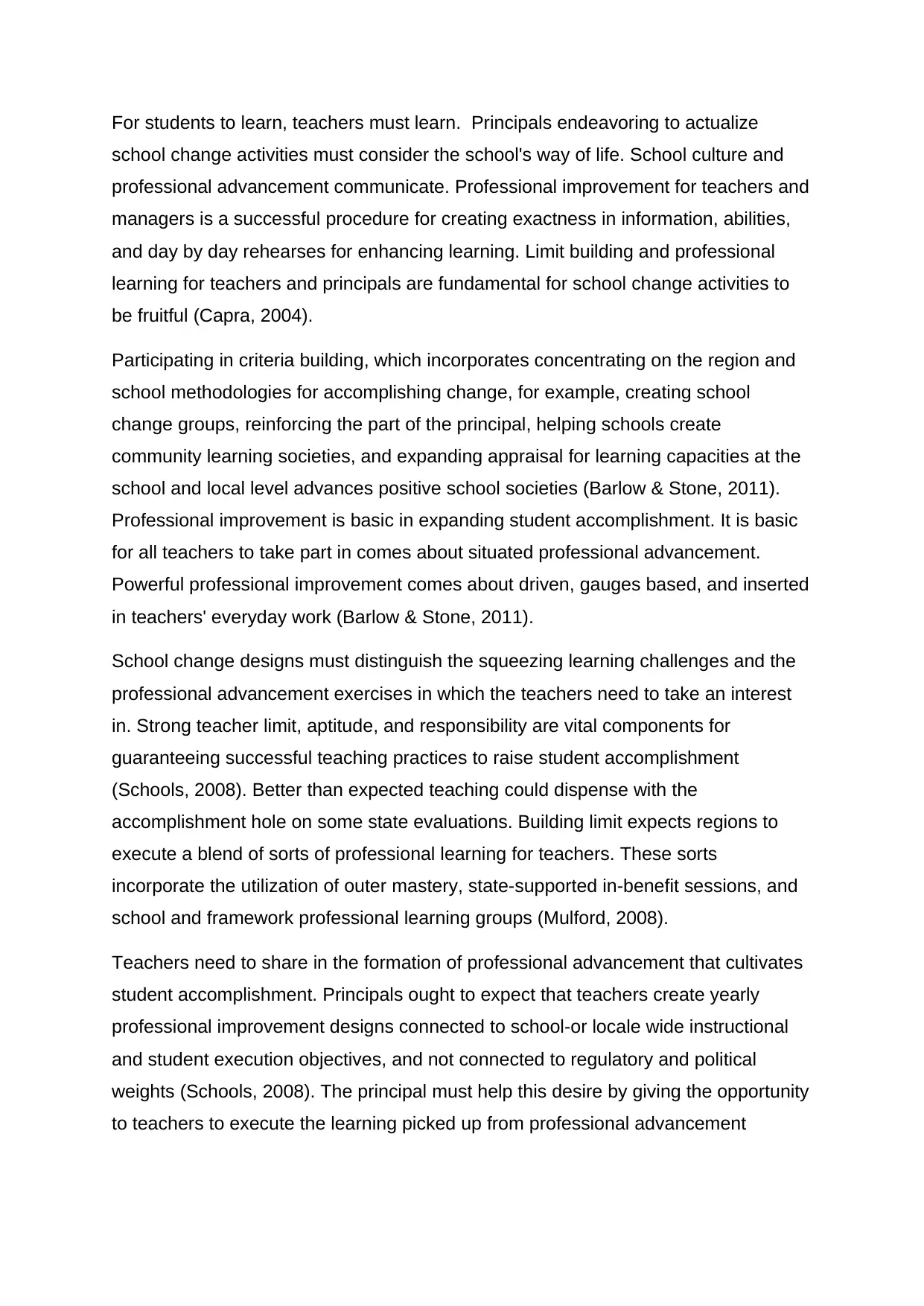
For students to learn, teachers must learn. Principals endeavoring to actualize
school change activities must consider the school's way of life. School culture and
professional advancement communicate. Professional improvement for teachers and
managers is a successful procedure for creating exactness in information, abilities,
and day by day rehearses for enhancing learning. Limit building and professional
learning for teachers and principals are fundamental for school change activities to
be fruitful (Capra, 2004).
Participating in criteria building, which incorporates concentrating on the region and
school methodologies for accomplishing change, for example, creating school
change groups, reinforcing the part of the principal, helping schools create
community learning societies, and expanding appraisal for learning capacities at the
school and local level advances positive school societies (Barlow & Stone, 2011).
Professional improvement is basic in expanding student accomplishment. It is basic
for all teachers to take part in comes about situated professional advancement.
Powerful professional improvement comes about driven, gauges based, and inserted
in teachers' everyday work (Barlow & Stone, 2011).
School change designs must distinguish the squeezing learning challenges and the
professional advancement exercises in which the teachers need to take an interest
in. Strong teacher limit, aptitude, and responsibility are vital components for
guaranteeing successful teaching practices to raise student accomplishment
(Schools, 2008). Better than expected teaching could dispense with the
accomplishment hole on some state evaluations. Building limit expects regions to
execute a blend of sorts of professional learning for teachers. These sorts
incorporate the utilization of outer mastery, state-supported in-benefit sessions, and
school and framework professional learning groups (Mulford, 2008).
Teachers need to share in the formation of professional advancement that cultivates
student accomplishment. Principals ought to expect that teachers create yearly
professional improvement designs connected to school-or locale wide instructional
and student execution objectives, and not connected to regulatory and political
weights (Schools, 2008). The principal must help this desire by giving the opportunity
to teachers to execute the learning picked up from professional advancement
school change activities must consider the school's way of life. School culture and
professional advancement communicate. Professional improvement for teachers and
managers is a successful procedure for creating exactness in information, abilities,
and day by day rehearses for enhancing learning. Limit building and professional
learning for teachers and principals are fundamental for school change activities to
be fruitful (Capra, 2004).
Participating in criteria building, which incorporates concentrating on the region and
school methodologies for accomplishing change, for example, creating school
change groups, reinforcing the part of the principal, helping schools create
community learning societies, and expanding appraisal for learning capacities at the
school and local level advances positive school societies (Barlow & Stone, 2011).
Professional improvement is basic in expanding student accomplishment. It is basic
for all teachers to take part in comes about situated professional advancement.
Powerful professional improvement comes about driven, gauges based, and inserted
in teachers' everyday work (Barlow & Stone, 2011).
School change designs must distinguish the squeezing learning challenges and the
professional advancement exercises in which the teachers need to take an interest
in. Strong teacher limit, aptitude, and responsibility are vital components for
guaranteeing successful teaching practices to raise student accomplishment
(Schools, 2008). Better than expected teaching could dispense with the
accomplishment hole on some state evaluations. Building limit expects regions to
execute a blend of sorts of professional learning for teachers. These sorts
incorporate the utilization of outer mastery, state-supported in-benefit sessions, and
school and framework professional learning groups (Mulford, 2008).
Teachers need to share in the formation of professional advancement that cultivates
student accomplishment. Principals ought to expect that teachers create yearly
professional improvement designs connected to school-or locale wide instructional
and student execution objectives, and not connected to regulatory and political
weights (Schools, 2008). The principal must help this desire by giving the opportunity
to teachers to execute the learning picked up from professional advancement
⊘ This is a preview!⊘
Do you want full access?
Subscribe today to unlock all pages.

Trusted by 1+ million students worldwide
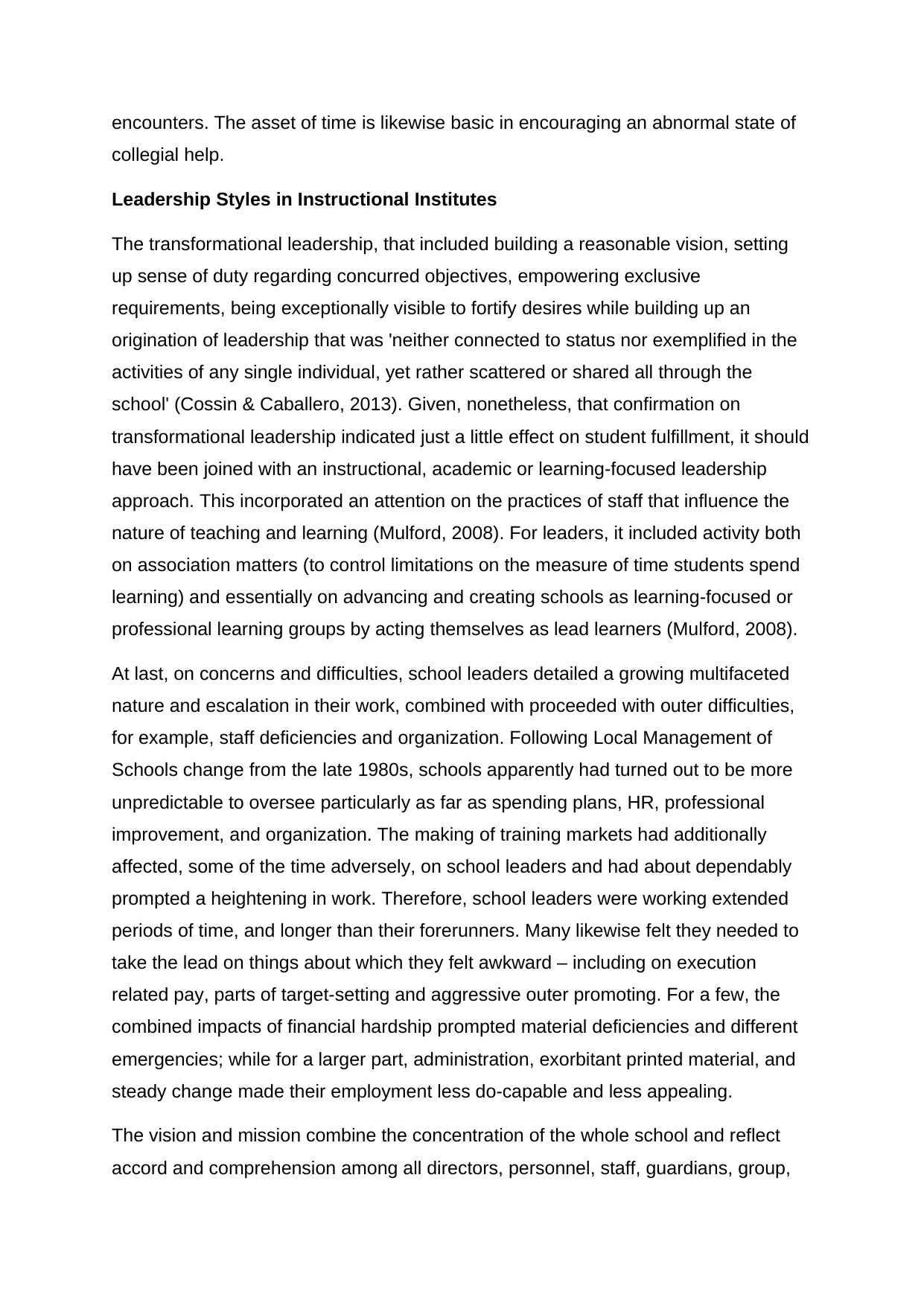
encounters. The asset of time is likewise basic in encouraging an abnormal state of
collegial help.
Leadership Styles in Instructional Institutes
The transformational leadership, that included building a reasonable vision, setting
up sense of duty regarding concurred objectives, empowering exclusive
requirements, being exceptionally visible to fortify desires while building up an
origination of leadership that was 'neither connected to status nor exemplified in the
activities of any single individual, yet rather scattered or shared all through the
school' (Cossin & Caballero, 2013). Given, nonetheless, that confirmation on
transformational leadership indicated just a little effect on student fulfillment, it should
have been joined with an instructional, academic or learning-focused leadership
approach. This incorporated an attention on the practices of staff that influence the
nature of teaching and learning (Mulford, 2008). For leaders, it included activity both
on association matters (to control limitations on the measure of time students spend
learning) and essentially on advancing and creating schools as learning-focused or
professional learning groups by acting themselves as lead learners (Mulford, 2008).
At last, on concerns and difficulties, school leaders detailed a growing multifaceted
nature and escalation in their work, combined with proceeded with outer difficulties,
for example, staff deficiencies and organization. Following Local Management of
Schools change from the late 1980s, schools apparently had turned out to be more
unpredictable to oversee particularly as far as spending plans, HR, professional
improvement, and organization. The making of training markets had additionally
affected, some of the time adversely, on school leaders and had about dependably
prompted a heightening in work. Therefore, school leaders were working extended
periods of time, and longer than their forerunners. Many likewise felt they needed to
take the lead on things about which they felt awkward – including on execution
related pay, parts of target-setting and aggressive outer promoting. For a few, the
combined impacts of financial hardship prompted material deficiencies and different
emergencies; while for a larger part, administration, exorbitant printed material, and
steady change made their employment less do-capable and less appealing.
The vision and mission combine the concentration of the whole school and reflect
accord and comprehension among all directors, personnel, staff, guardians, group,
collegial help.
Leadership Styles in Instructional Institutes
The transformational leadership, that included building a reasonable vision, setting
up sense of duty regarding concurred objectives, empowering exclusive
requirements, being exceptionally visible to fortify desires while building up an
origination of leadership that was 'neither connected to status nor exemplified in the
activities of any single individual, yet rather scattered or shared all through the
school' (Cossin & Caballero, 2013). Given, nonetheless, that confirmation on
transformational leadership indicated just a little effect on student fulfillment, it should
have been joined with an instructional, academic or learning-focused leadership
approach. This incorporated an attention on the practices of staff that influence the
nature of teaching and learning (Mulford, 2008). For leaders, it included activity both
on association matters (to control limitations on the measure of time students spend
learning) and essentially on advancing and creating schools as learning-focused or
professional learning groups by acting themselves as lead learners (Mulford, 2008).
At last, on concerns and difficulties, school leaders detailed a growing multifaceted
nature and escalation in their work, combined with proceeded with outer difficulties,
for example, staff deficiencies and organization. Following Local Management of
Schools change from the late 1980s, schools apparently had turned out to be more
unpredictable to oversee particularly as far as spending plans, HR, professional
improvement, and organization. The making of training markets had additionally
affected, some of the time adversely, on school leaders and had about dependably
prompted a heightening in work. Therefore, school leaders were working extended
periods of time, and longer than their forerunners. Many likewise felt they needed to
take the lead on things about which they felt awkward – including on execution
related pay, parts of target-setting and aggressive outer promoting. For a few, the
combined impacts of financial hardship prompted material deficiencies and different
emergencies; while for a larger part, administration, exorbitant printed material, and
steady change made their employment less do-capable and less appealing.
The vision and mission combine the concentration of the whole school and reflect
accord and comprehension among all directors, personnel, staff, guardians, group,
Paraphrase This Document
Need a fresh take? Get an instant paraphrase of this document with our AI Paraphraser
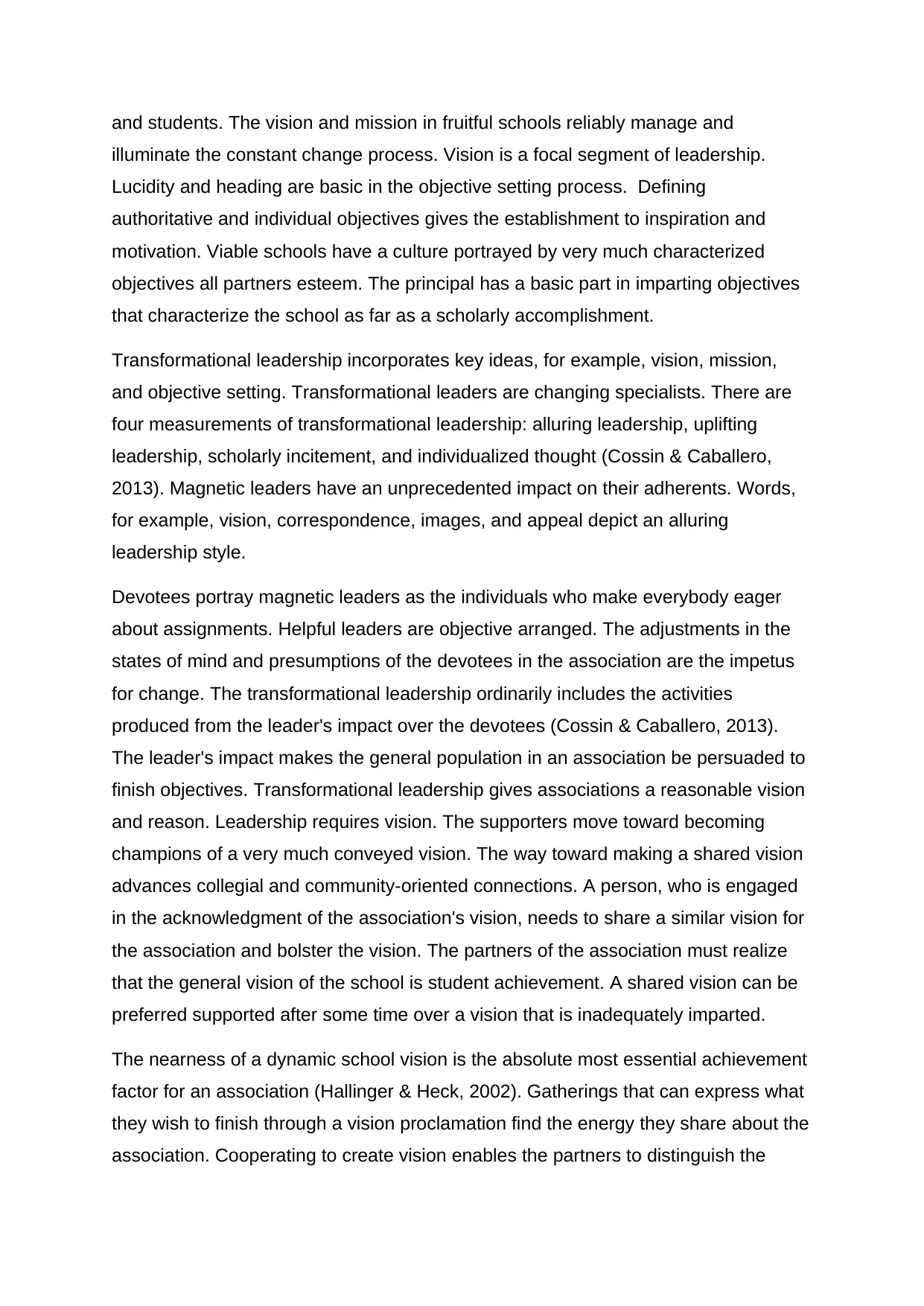
and students. The vision and mission in fruitful schools reliably manage and
illuminate the constant change process. Vision is a focal segment of leadership.
Lucidity and heading are basic in the objective setting process. Defining
authoritative and individual objectives gives the establishment to inspiration and
motivation. Viable schools have a culture portrayed by very much characterized
objectives all partners esteem. The principal has a basic part in imparting objectives
that characterize the school as far as a scholarly accomplishment.
Transformational leadership incorporates key ideas, for example, vision, mission,
and objective setting. Transformational leaders are changing specialists. There are
four measurements of transformational leadership: alluring leadership, uplifting
leadership, scholarly incitement, and individualized thought (Cossin & Caballero,
2013). Magnetic leaders have an unprecedented impact on their adherents. Words,
for example, vision, correspondence, images, and appeal depict an alluring
leadership style.
Devotees portray magnetic leaders as the individuals who make everybody eager
about assignments. Helpful leaders are objective arranged. The adjustments in the
states of mind and presumptions of the devotees in the association are the impetus
for change. The transformational leadership ordinarily includes the activities
produced from the leader's impact over the devotees (Cossin & Caballero, 2013).
The leader's impact makes the general population in an association be persuaded to
finish objectives. Transformational leadership gives associations a reasonable vision
and reason. Leadership requires vision. The supporters move toward becoming
champions of a very much conveyed vision. The way toward making a shared vision
advances collegial and community-oriented connections. A person, who is engaged
in the acknowledgment of the association's vision, needs to share a similar vision for
the association and bolster the vision. The partners of the association must realize
that the general vision of the school is student achievement. A shared vision can be
preferred supported after some time over a vision that is inadequately imparted.
The nearness of a dynamic school vision is the absolute most essential achievement
factor for an association (Hallinger & Heck, 2002). Gatherings that can express what
they wish to finish through a vision proclamation find the energy they share about the
association. Cooperating to create vision enables the partners to distinguish the
illuminate the constant change process. Vision is a focal segment of leadership.
Lucidity and heading are basic in the objective setting process. Defining
authoritative and individual objectives gives the establishment to inspiration and
motivation. Viable schools have a culture portrayed by very much characterized
objectives all partners esteem. The principal has a basic part in imparting objectives
that characterize the school as far as a scholarly accomplishment.
Transformational leadership incorporates key ideas, for example, vision, mission,
and objective setting. Transformational leaders are changing specialists. There are
four measurements of transformational leadership: alluring leadership, uplifting
leadership, scholarly incitement, and individualized thought (Cossin & Caballero,
2013). Magnetic leaders have an unprecedented impact on their adherents. Words,
for example, vision, correspondence, images, and appeal depict an alluring
leadership style.
Devotees portray magnetic leaders as the individuals who make everybody eager
about assignments. Helpful leaders are objective arranged. The adjustments in the
states of mind and presumptions of the devotees in the association are the impetus
for change. The transformational leadership ordinarily includes the activities
produced from the leader's impact over the devotees (Cossin & Caballero, 2013).
The leader's impact makes the general population in an association be persuaded to
finish objectives. Transformational leadership gives associations a reasonable vision
and reason. Leadership requires vision. The supporters move toward becoming
champions of a very much conveyed vision. The way toward making a shared vision
advances collegial and community-oriented connections. A person, who is engaged
in the acknowledgment of the association's vision, needs to share a similar vision for
the association and bolster the vision. The partners of the association must realize
that the general vision of the school is student achievement. A shared vision can be
preferred supported after some time over a vision that is inadequately imparted.
The nearness of a dynamic school vision is the absolute most essential achievement
factor for an association (Hallinger & Heck, 2002). Gatherings that can express what
they wish to finish through a vision proclamation find the energy they share about the
association. Cooperating to create vision enables the partners to distinguish the
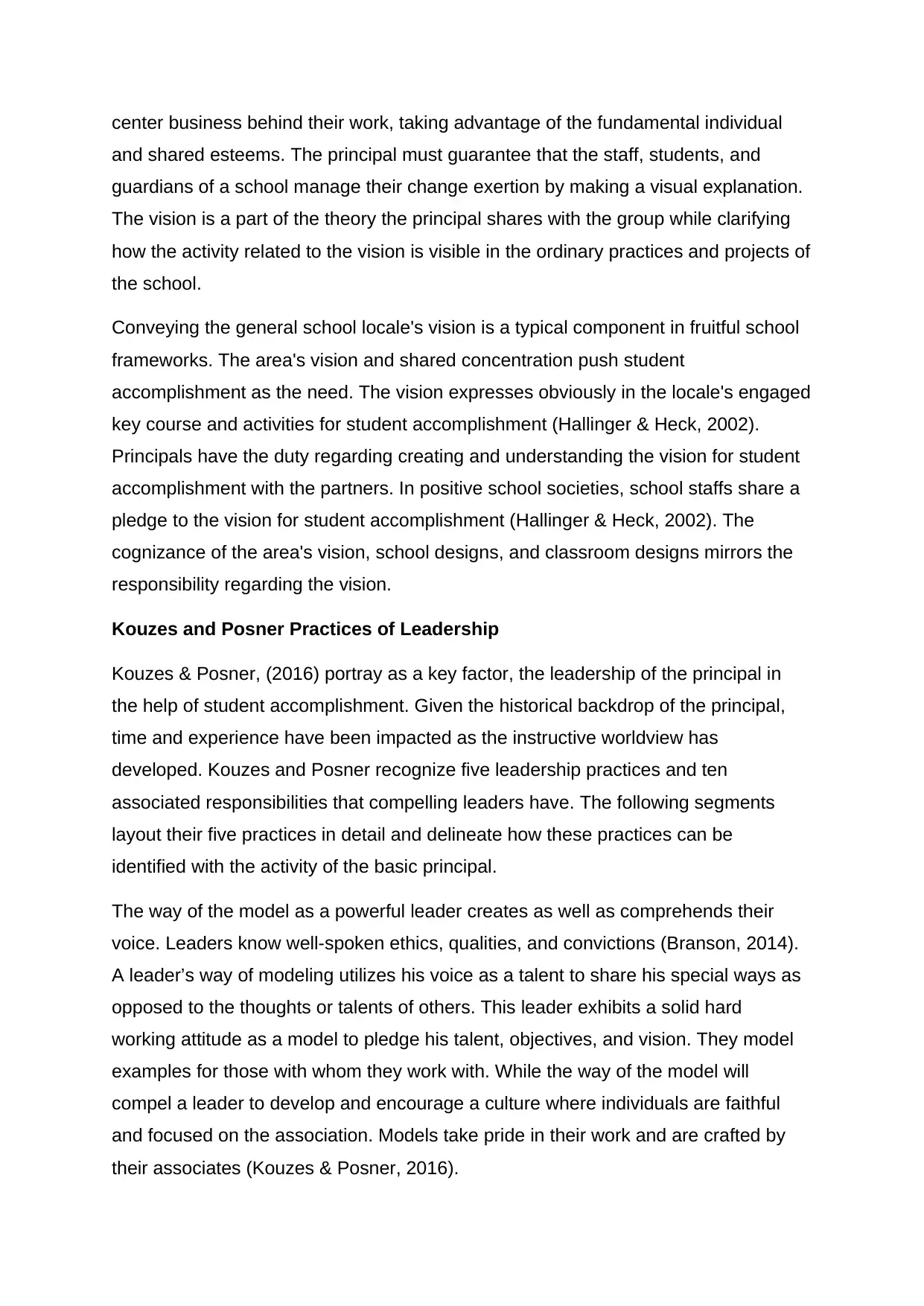
center business behind their work, taking advantage of the fundamental individual
and shared esteems. The principal must guarantee that the staff, students, and
guardians of a school manage their change exertion by making a visual explanation.
The vision is a part of the theory the principal shares with the group while clarifying
how the activity related to the vision is visible in the ordinary practices and projects of
the school.
Conveying the general school locale's vision is a typical component in fruitful school
frameworks. The area's vision and shared concentration push student
accomplishment as the need. The vision expresses obviously in the locale's engaged
key course and activities for student accomplishment (Hallinger & Heck, 2002).
Principals have the duty regarding creating and understanding the vision for student
accomplishment with the partners. In positive school societies, school staffs share a
pledge to the vision for student accomplishment (Hallinger & Heck, 2002). The
cognizance of the area's vision, school designs, and classroom designs mirrors the
responsibility regarding the vision.
Kouzes and Posner Practices of Leadership
Kouzes & Posner, (2016) portray as a key factor, the leadership of the principal in
the help of student accomplishment. Given the historical backdrop of the principal,
time and experience have been impacted as the instructive worldview has
developed. Kouzes and Posner recognize five leadership practices and ten
associated responsibilities that compelling leaders have. The following segments
layout their five practices in detail and delineate how these practices can be
identified with the activity of the basic principal.
The way of the model as a powerful leader creates as well as comprehends their
voice. Leaders know well-spoken ethics, qualities, and convictions (Branson, 2014).
A leader’s way of modeling utilizes his voice as a talent to share his special ways as
opposed to the thoughts or talents of others. This leader exhibits a solid hard
working attitude as a model to pledge his talent, objectives, and vision. They model
examples for those with whom they work with. While the way of the model will
compel a leader to develop and encourage a culture where individuals are faithful
and focused on the association. Models take pride in their work and are crafted by
their associates (Kouzes & Posner, 2016).
and shared esteems. The principal must guarantee that the staff, students, and
guardians of a school manage their change exertion by making a visual explanation.
The vision is a part of the theory the principal shares with the group while clarifying
how the activity related to the vision is visible in the ordinary practices and projects of
the school.
Conveying the general school locale's vision is a typical component in fruitful school
frameworks. The area's vision and shared concentration push student
accomplishment as the need. The vision expresses obviously in the locale's engaged
key course and activities for student accomplishment (Hallinger & Heck, 2002).
Principals have the duty regarding creating and understanding the vision for student
accomplishment with the partners. In positive school societies, school staffs share a
pledge to the vision for student accomplishment (Hallinger & Heck, 2002). The
cognizance of the area's vision, school designs, and classroom designs mirrors the
responsibility regarding the vision.
Kouzes and Posner Practices of Leadership
Kouzes & Posner, (2016) portray as a key factor, the leadership of the principal in
the help of student accomplishment. Given the historical backdrop of the principal,
time and experience have been impacted as the instructive worldview has
developed. Kouzes and Posner recognize five leadership practices and ten
associated responsibilities that compelling leaders have. The following segments
layout their five practices in detail and delineate how these practices can be
identified with the activity of the basic principal.
The way of the model as a powerful leader creates as well as comprehends their
voice. Leaders know well-spoken ethics, qualities, and convictions (Branson, 2014).
A leader’s way of modeling utilizes his voice as a talent to share his special ways as
opposed to the thoughts or talents of others. This leader exhibits a solid hard
working attitude as a model to pledge his talent, objectives, and vision. They model
examples for those with whom they work with. While the way of the model will
compel a leader to develop and encourage a culture where individuals are faithful
and focused on the association. Models take pride in their work and are crafted by
their associates (Kouzes & Posner, 2016).
⊘ This is a preview!⊘
Do you want full access?
Subscribe today to unlock all pages.

Trusted by 1+ million students worldwide
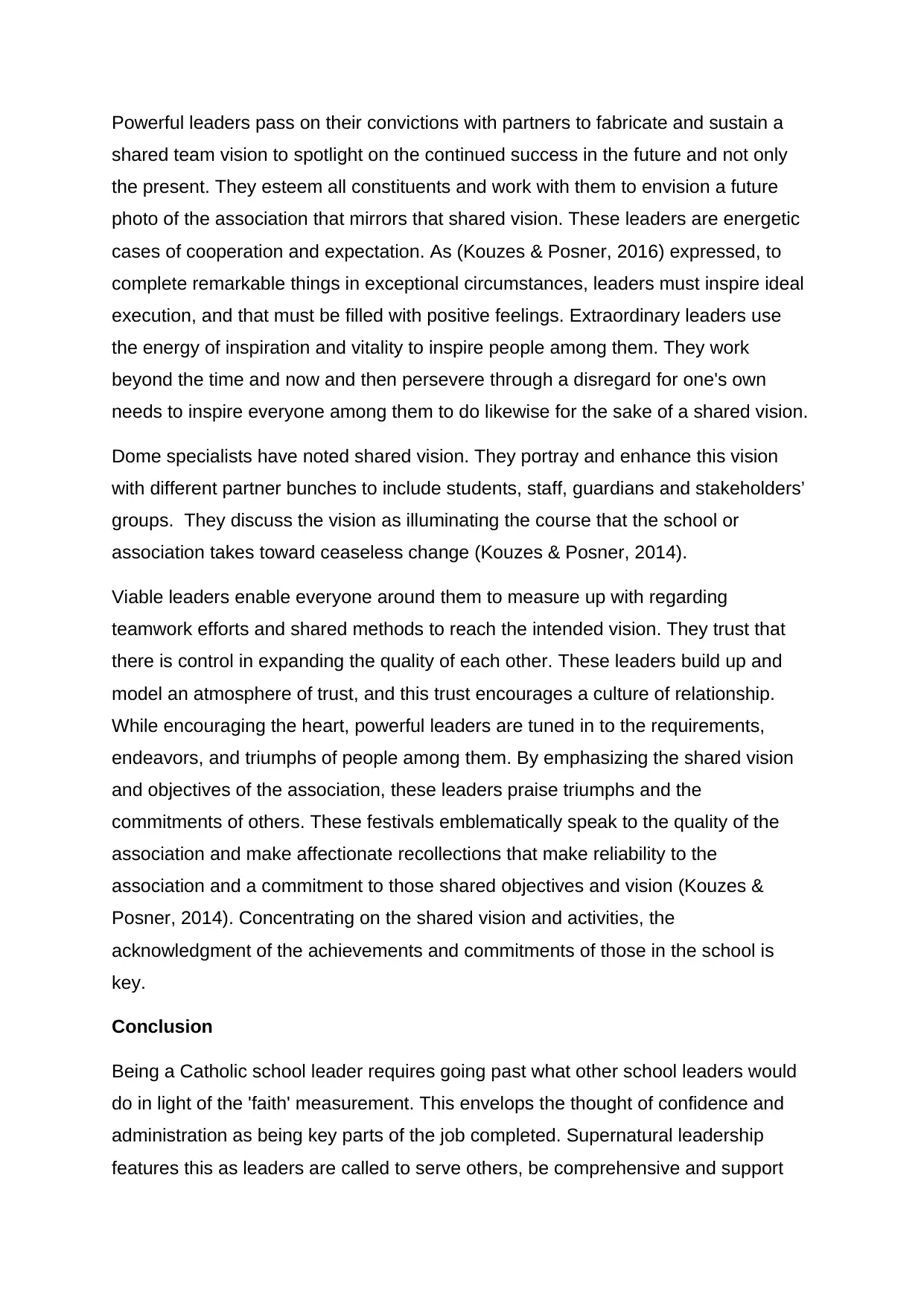
Powerful leaders pass on their convictions with partners to fabricate and sustain a
shared team vision to spotlight on the continued success in the future and not only
the present. They esteem all constituents and work with them to envision a future
photo of the association that mirrors that shared vision. These leaders are energetic
cases of cooperation and expectation. As (Kouzes & Posner, 2016) expressed, to
complete remarkable things in exceptional circumstances, leaders must inspire ideal
execution, and that must be filled with positive feelings. Extraordinary leaders use
the energy of inspiration and vitality to inspire people among them. They work
beyond the time and now and then persevere through a disregard for one's own
needs to inspire everyone among them to do likewise for the sake of a shared vision.
Dome specialists have noted shared vision. They portray and enhance this vision
with different partner bunches to include students, staff, guardians and stakeholders’
groups. They discuss the vision as illuminating the course that the school or
association takes toward ceaseless change (Kouzes & Posner, 2014).
Viable leaders enable everyone around them to measure up with regarding
teamwork efforts and shared methods to reach the intended vision. They trust that
there is control in expanding the quality of each other. These leaders build up and
model an atmosphere of trust, and this trust encourages a culture of relationship.
While encouraging the heart, powerful leaders are tuned in to the requirements,
endeavors, and triumphs of people among them. By emphasizing the shared vision
and objectives of the association, these leaders praise triumphs and the
commitments of others. These festivals emblematically speak to the quality of the
association and make affectionate recollections that make reliability to the
association and a commitment to those shared objectives and vision (Kouzes &
Posner, 2014). Concentrating on the shared vision and activities, the
acknowledgment of the achievements and commitments of those in the school is
key.
Conclusion
Being a Catholic school leader requires going past what other school leaders would
do in light of the 'faith' measurement. This envelops the thought of confidence and
administration as being key parts of the job completed. Supernatural leadership
features this as leaders are called to serve others, be comprehensive and support
shared team vision to spotlight on the continued success in the future and not only
the present. They esteem all constituents and work with them to envision a future
photo of the association that mirrors that shared vision. These leaders are energetic
cases of cooperation and expectation. As (Kouzes & Posner, 2016) expressed, to
complete remarkable things in exceptional circumstances, leaders must inspire ideal
execution, and that must be filled with positive feelings. Extraordinary leaders use
the energy of inspiration and vitality to inspire people among them. They work
beyond the time and now and then persevere through a disregard for one's own
needs to inspire everyone among them to do likewise for the sake of a shared vision.
Dome specialists have noted shared vision. They portray and enhance this vision
with different partner bunches to include students, staff, guardians and stakeholders’
groups. They discuss the vision as illuminating the course that the school or
association takes toward ceaseless change (Kouzes & Posner, 2014).
Viable leaders enable everyone around them to measure up with regarding
teamwork efforts and shared methods to reach the intended vision. They trust that
there is control in expanding the quality of each other. These leaders build up and
model an atmosphere of trust, and this trust encourages a culture of relationship.
While encouraging the heart, powerful leaders are tuned in to the requirements,
endeavors, and triumphs of people among them. By emphasizing the shared vision
and objectives of the association, these leaders praise triumphs and the
commitments of others. These festivals emblematically speak to the quality of the
association and make affectionate recollections that make reliability to the
association and a commitment to those shared objectives and vision (Kouzes &
Posner, 2014). Concentrating on the shared vision and activities, the
acknowledgment of the achievements and commitments of those in the school is
key.
Conclusion
Being a Catholic school leader requires going past what other school leaders would
do in light of the 'faith' measurement. This envelops the thought of confidence and
administration as being key parts of the job completed. Supernatural leadership
features this as leaders are called to serve others, be comprehensive and support
Paraphrase This Document
Need a fresh take? Get an instant paraphrase of this document with our AI Paraphraser
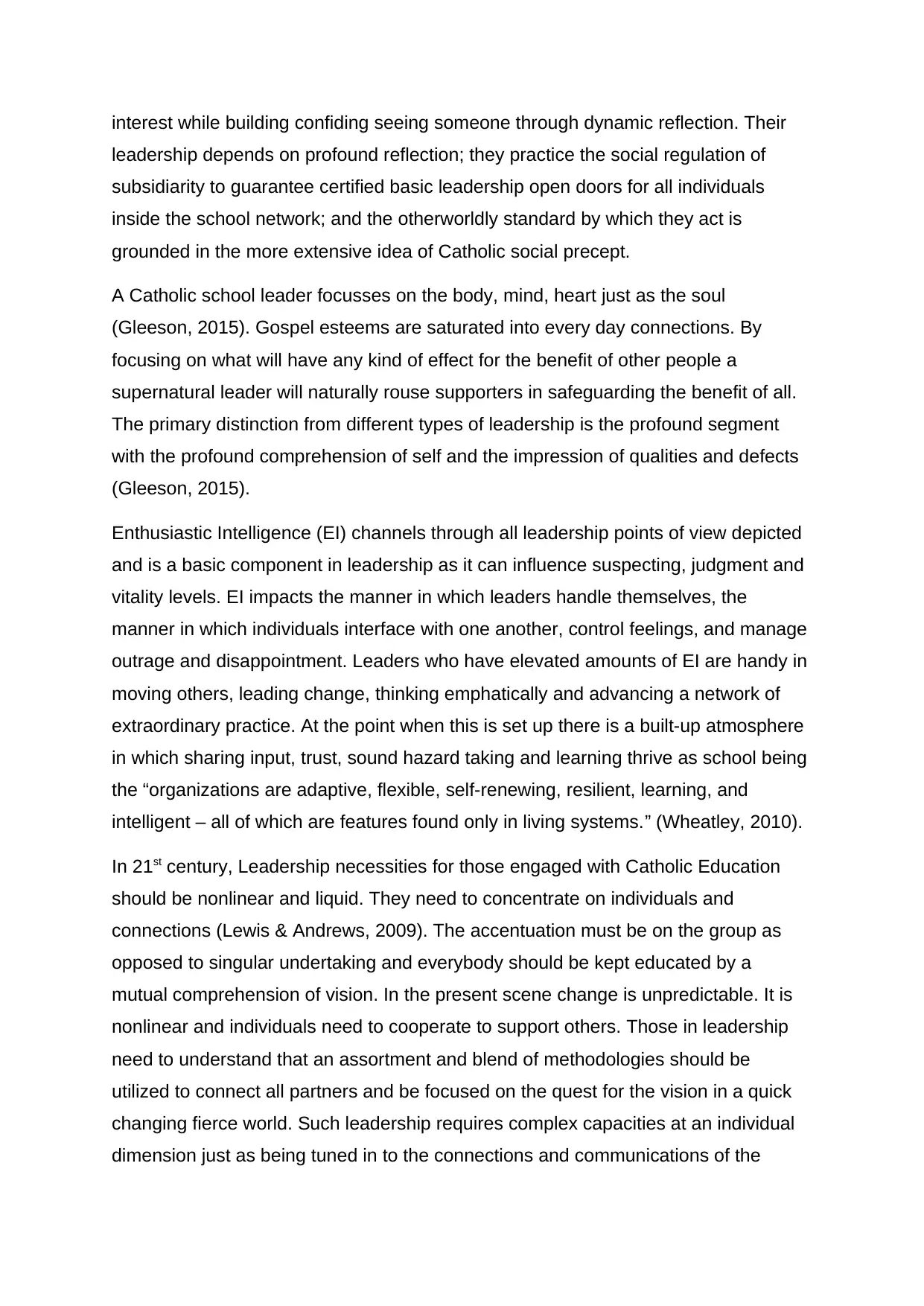
interest while building confiding seeing someone through dynamic reflection. Their
leadership depends on profound reflection; they practice the social regulation of
subsidiarity to guarantee certified basic leadership open doors for all individuals
inside the school network; and the otherworldly standard by which they act is
grounded in the more extensive idea of Catholic social precept.
A Catholic school leader focusses on the body, mind, heart just as the soul
(Gleeson, 2015). Gospel esteems are saturated into every day connections. By
focusing on what will have any kind of effect for the benefit of other people a
supernatural leader will naturally rouse supporters in safeguarding the benefit of all.
The primary distinction from different types of leadership is the profound segment
with the profound comprehension of self and the impression of qualities and defects
(Gleeson, 2015).
Enthusiastic Intelligence (EI) channels through all leadership points of view depicted
and is a basic component in leadership as it can influence suspecting, judgment and
vitality levels. EI impacts the manner in which leaders handle themselves, the
manner in which individuals interface with one another, control feelings, and manage
outrage and disappointment. Leaders who have elevated amounts of EI are handy in
moving others, leading change, thinking emphatically and advancing a network of
extraordinary practice. At the point when this is set up there is a built-up atmosphere
in which sharing input, trust, sound hazard taking and learning thrive as school being
the “organizations are adaptive, flexible, self-renewing, resilient, learning, and
intelligent – all of which are features found only in living systems.” (Wheatley, 2010).
In 21st century, Leadership necessities for those engaged with Catholic Education
should be nonlinear and liquid. They need to concentrate on individuals and
connections (Lewis & Andrews, 2009). The accentuation must be on the group as
opposed to singular undertaking and everybody should be kept educated by a
mutual comprehension of vision. In the present scene change is unpredictable. It is
nonlinear and individuals need to cooperate to support others. Those in leadership
need to understand that an assortment and blend of methodologies should be
utilized to connect all partners and be focused on the quest for the vision in a quick
changing fierce world. Such leadership requires complex capacities at an individual
dimension just as being tuned in to the connections and communications of the
leadership depends on profound reflection; they practice the social regulation of
subsidiarity to guarantee certified basic leadership open doors for all individuals
inside the school network; and the otherworldly standard by which they act is
grounded in the more extensive idea of Catholic social precept.
A Catholic school leader focusses on the body, mind, heart just as the soul
(Gleeson, 2015). Gospel esteems are saturated into every day connections. By
focusing on what will have any kind of effect for the benefit of other people a
supernatural leader will naturally rouse supporters in safeguarding the benefit of all.
The primary distinction from different types of leadership is the profound segment
with the profound comprehension of self and the impression of qualities and defects
(Gleeson, 2015).
Enthusiastic Intelligence (EI) channels through all leadership points of view depicted
and is a basic component in leadership as it can influence suspecting, judgment and
vitality levels. EI impacts the manner in which leaders handle themselves, the
manner in which individuals interface with one another, control feelings, and manage
outrage and disappointment. Leaders who have elevated amounts of EI are handy in
moving others, leading change, thinking emphatically and advancing a network of
extraordinary practice. At the point when this is set up there is a built-up atmosphere
in which sharing input, trust, sound hazard taking and learning thrive as school being
the “organizations are adaptive, flexible, self-renewing, resilient, learning, and
intelligent – all of which are features found only in living systems.” (Wheatley, 2010).
In 21st century, Leadership necessities for those engaged with Catholic Education
should be nonlinear and liquid. They need to concentrate on individuals and
connections (Lewis & Andrews, 2009). The accentuation must be on the group as
opposed to singular undertaking and everybody should be kept educated by a
mutual comprehension of vision. In the present scene change is unpredictable. It is
nonlinear and individuals need to cooperate to support others. Those in leadership
need to understand that an assortment and blend of methodologies should be
utilized to connect all partners and be focused on the quest for the vision in a quick
changing fierce world. Such leadership requires complex capacities at an individual
dimension just as being tuned in to the connections and communications of the
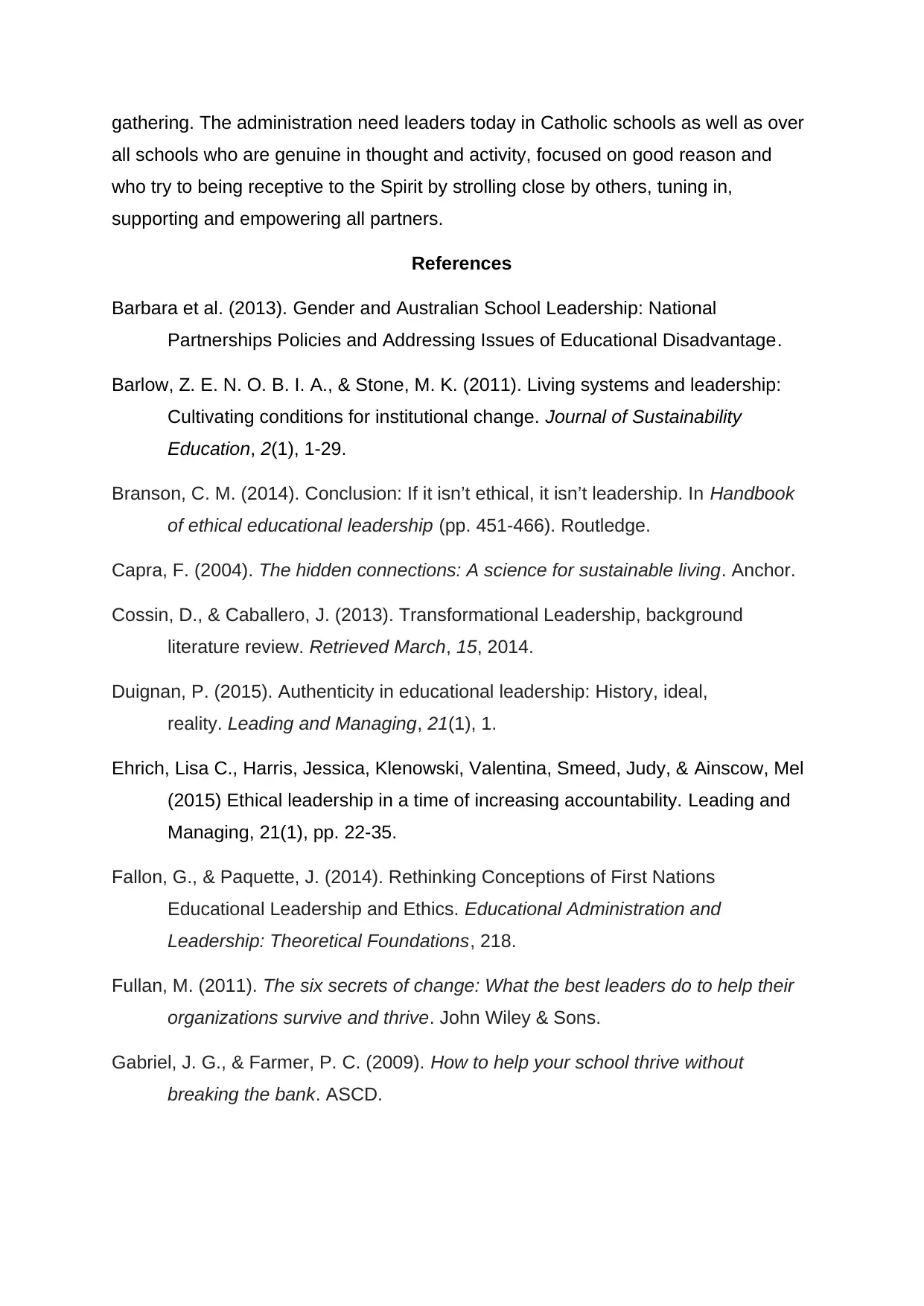
gathering. The administration need leaders today in Catholic schools as well as over
all schools who are genuine in thought and activity, focused on good reason and
who try to being receptive to the Spirit by strolling close by others, tuning in,
supporting and empowering all partners.
References
Barbara et al. (2013). Gender and Australian School Leadership: National
Partnerships Policies and Addressing Issues of Educational Disadvantage.
Barlow, Z. E. N. O. B. I. A., & Stone, M. K. (2011). Living systems and leadership:
Cultivating conditions for institutional change. Journal of Sustainability
Education, 2(1), 1-29.
Branson, C. M. (2014). Conclusion: If it isn’t ethical, it isn’t leadership. In Handbook
of ethical educational leadership (pp. 451-466). Routledge.
Capra, F. (2004). The hidden connections: A science for sustainable living. Anchor.
Cossin, D., & Caballero, J. (2013). Transformational Leadership, background
literature review. Retrieved March, 15, 2014.
Duignan, P. (2015). Authenticity in educational leadership: History, ideal,
reality. Leading and Managing, 21(1), 1.
Ehrich, Lisa C., Harris, Jessica, Klenowski, Valentina, Smeed, Judy, & Ainscow, Mel
(2015) Ethical leadership in a time of increasing accountability. Leading and
Managing, 21(1), pp. 22-35.
Fallon, G., & Paquette, J. (2014). Rethinking Conceptions of First Nations
Educational Leadership and Ethics. Educational Administration and
Leadership: Theoretical Foundations, 218.
Fullan, M. (2011). The six secrets of change: What the best leaders do to help their
organizations survive and thrive. John Wiley & Sons.
Gabriel, J. G., & Farmer, P. C. (2009). How to help your school thrive without
breaking the bank. ASCD.
all schools who are genuine in thought and activity, focused on good reason and
who try to being receptive to the Spirit by strolling close by others, tuning in,
supporting and empowering all partners.
References
Barbara et al. (2013). Gender and Australian School Leadership: National
Partnerships Policies and Addressing Issues of Educational Disadvantage.
Barlow, Z. E. N. O. B. I. A., & Stone, M. K. (2011). Living systems and leadership:
Cultivating conditions for institutional change. Journal of Sustainability
Education, 2(1), 1-29.
Branson, C. M. (2014). Conclusion: If it isn’t ethical, it isn’t leadership. In Handbook
of ethical educational leadership (pp. 451-466). Routledge.
Capra, F. (2004). The hidden connections: A science for sustainable living. Anchor.
Cossin, D., & Caballero, J. (2013). Transformational Leadership, background
literature review. Retrieved March, 15, 2014.
Duignan, P. (2015). Authenticity in educational leadership: History, ideal,
reality. Leading and Managing, 21(1), 1.
Ehrich, Lisa C., Harris, Jessica, Klenowski, Valentina, Smeed, Judy, & Ainscow, Mel
(2015) Ethical leadership in a time of increasing accountability. Leading and
Managing, 21(1), pp. 22-35.
Fallon, G., & Paquette, J. (2014). Rethinking Conceptions of First Nations
Educational Leadership and Ethics. Educational Administration and
Leadership: Theoretical Foundations, 218.
Fullan, M. (2011). The six secrets of change: What the best leaders do to help their
organizations survive and thrive. John Wiley & Sons.
Gabriel, J. G., & Farmer, P. C. (2009). How to help your school thrive without
breaking the bank. ASCD.
⊘ This is a preview!⊘
Do you want full access?
Subscribe today to unlock all pages.

Trusted by 1+ million students worldwide
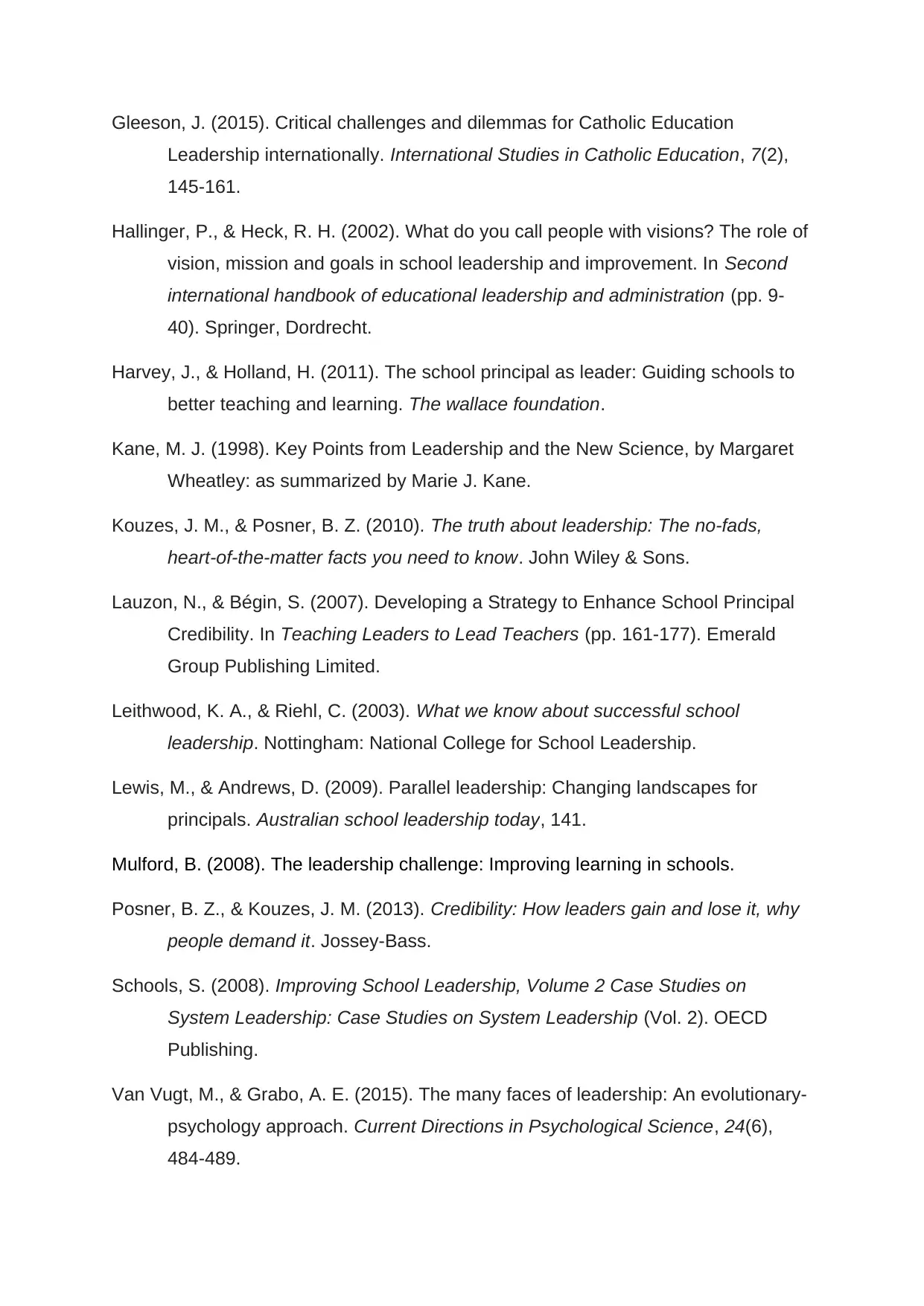
Gleeson, J. (2015). Critical challenges and dilemmas for Catholic Education
Leadership internationally. International Studies in Catholic Education, 7(2),
145-161.
Hallinger, P., & Heck, R. H. (2002). What do you call people with visions? The role of
vision, mission and goals in school leadership and improvement. In Second
international handbook of educational leadership and administration (pp. 9-
40). Springer, Dordrecht.
Harvey, J., & Holland, H. (2011). The school principal as leader: Guiding schools to
better teaching and learning. The wallace foundation.
Kane, M. J. (1998). Key Points from Leadership and the New Science, by Margaret
Wheatley: as summarized by Marie J. Kane.
Kouzes, J. M., & Posner, B. Z. (2010). The truth about leadership: The no-fads,
heart-of-the-matter facts you need to know. John Wiley & Sons.
Lauzon, N., & Bégin, S. (2007). Developing a Strategy to Enhance School Principal
Credibility. In Teaching Leaders to Lead Teachers (pp. 161-177). Emerald
Group Publishing Limited.
Leithwood, K. A., & Riehl, C. (2003). What we know about successful school
leadership. Nottingham: National College for School Leadership.
Lewis, M., & Andrews, D. (2009). Parallel leadership: Changing landscapes for
principals. Australian school leadership today, 141.
Mulford, B. (2008). The leadership challenge: Improving learning in schools.
Posner, B. Z., & Kouzes, J. M. (2013). Credibility: How leaders gain and lose it, why
people demand it. Jossey-Bass.
Schools, S. (2008). Improving School Leadership, Volume 2 Case Studies on
System Leadership: Case Studies on System Leadership (Vol. 2). OECD
Publishing.
Van Vugt, M., & Grabo, A. E. (2015). The many faces of leadership: An evolutionary-
psychology approach. Current Directions in Psychological Science, 24(6),
484-489.
Leadership internationally. International Studies in Catholic Education, 7(2),
145-161.
Hallinger, P., & Heck, R. H. (2002). What do you call people with visions? The role of
vision, mission and goals in school leadership and improvement. In Second
international handbook of educational leadership and administration (pp. 9-
40). Springer, Dordrecht.
Harvey, J., & Holland, H. (2011). The school principal as leader: Guiding schools to
better teaching and learning. The wallace foundation.
Kane, M. J. (1998). Key Points from Leadership and the New Science, by Margaret
Wheatley: as summarized by Marie J. Kane.
Kouzes, J. M., & Posner, B. Z. (2010). The truth about leadership: The no-fads,
heart-of-the-matter facts you need to know. John Wiley & Sons.
Lauzon, N., & Bégin, S. (2007). Developing a Strategy to Enhance School Principal
Credibility. In Teaching Leaders to Lead Teachers (pp. 161-177). Emerald
Group Publishing Limited.
Leithwood, K. A., & Riehl, C. (2003). What we know about successful school
leadership. Nottingham: National College for School Leadership.
Lewis, M., & Andrews, D. (2009). Parallel leadership: Changing landscapes for
principals. Australian school leadership today, 141.
Mulford, B. (2008). The leadership challenge: Improving learning in schools.
Posner, B. Z., & Kouzes, J. M. (2013). Credibility: How leaders gain and lose it, why
people demand it. Jossey-Bass.
Schools, S. (2008). Improving School Leadership, Volume 2 Case Studies on
System Leadership: Case Studies on System Leadership (Vol. 2). OECD
Publishing.
Van Vugt, M., & Grabo, A. E. (2015). The many faces of leadership: An evolutionary-
psychology approach. Current Directions in Psychological Science, 24(6),
484-489.
Paraphrase This Document
Need a fresh take? Get an instant paraphrase of this document with our AI Paraphraser
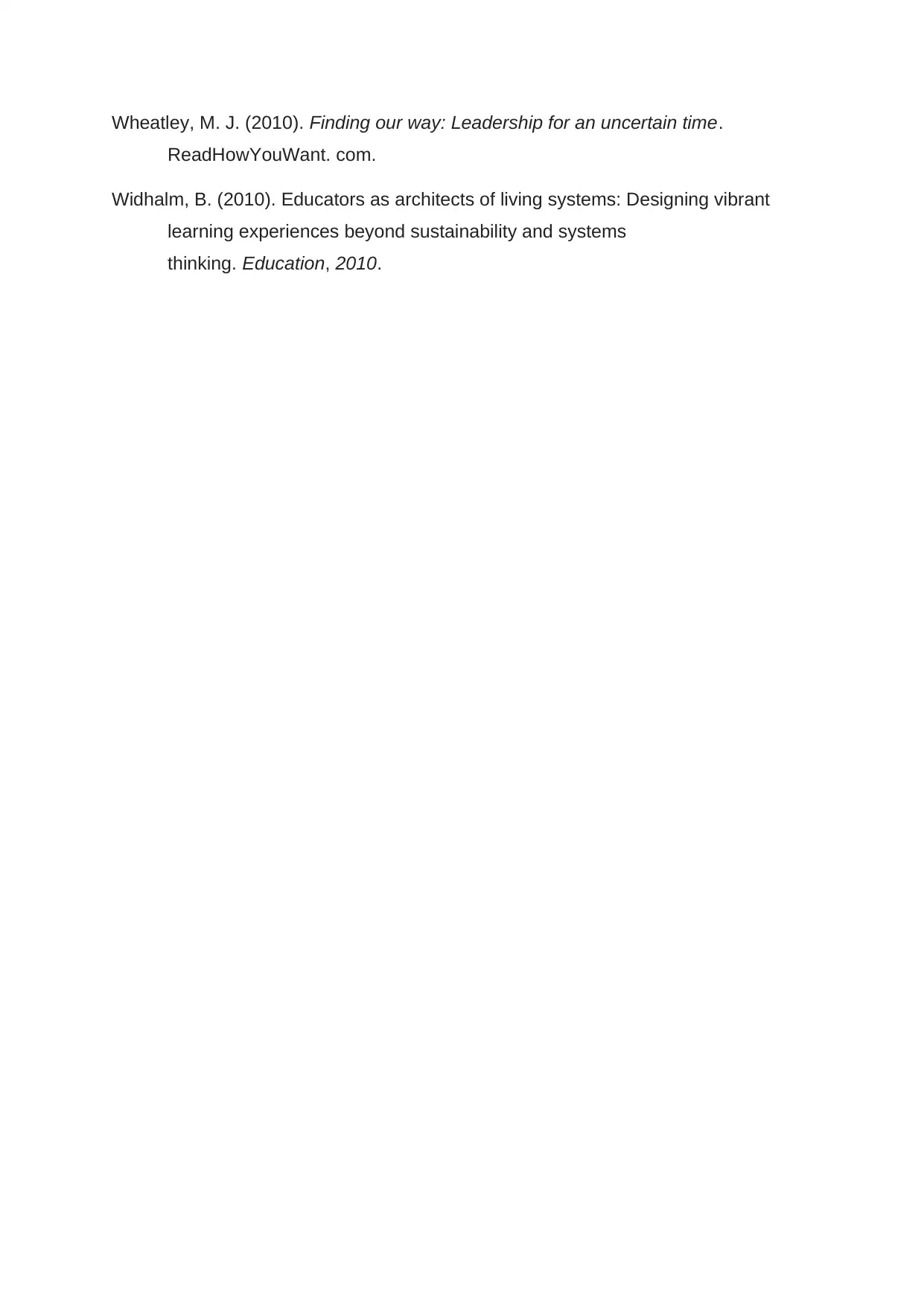
Wheatley, M. J. (2010). Finding our way: Leadership for an uncertain time.
ReadHowYouWant. com.
Widhalm, B. (2010). Educators as architects of living systems: Designing vibrant
learning experiences beyond sustainability and systems
thinking. Education, 2010.
ReadHowYouWant. com.
Widhalm, B. (2010). Educators as architects of living systems: Designing vibrant
learning experiences beyond sustainability and systems
thinking. Education, 2010.
1 out of 11
Related Documents
Your All-in-One AI-Powered Toolkit for Academic Success.
+13062052269
info@desklib.com
Available 24*7 on WhatsApp / Email
![[object Object]](/_next/static/media/star-bottom.7253800d.svg)
Unlock your academic potential
Copyright © 2020–2025 A2Z Services. All Rights Reserved. Developed and managed by ZUCOL.



